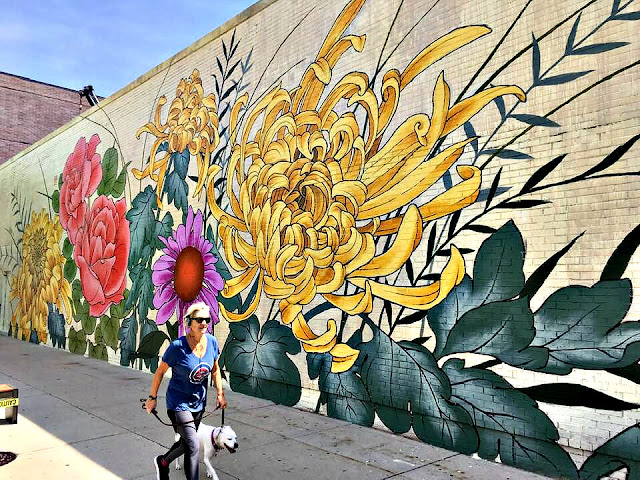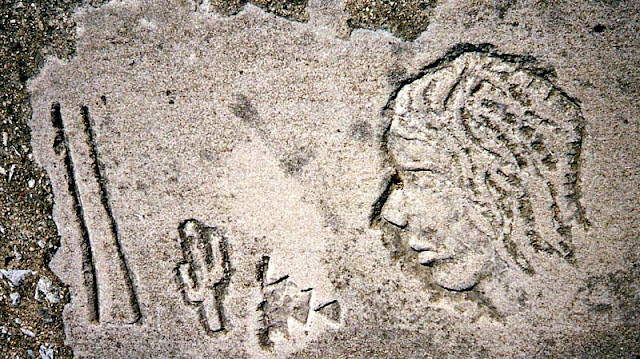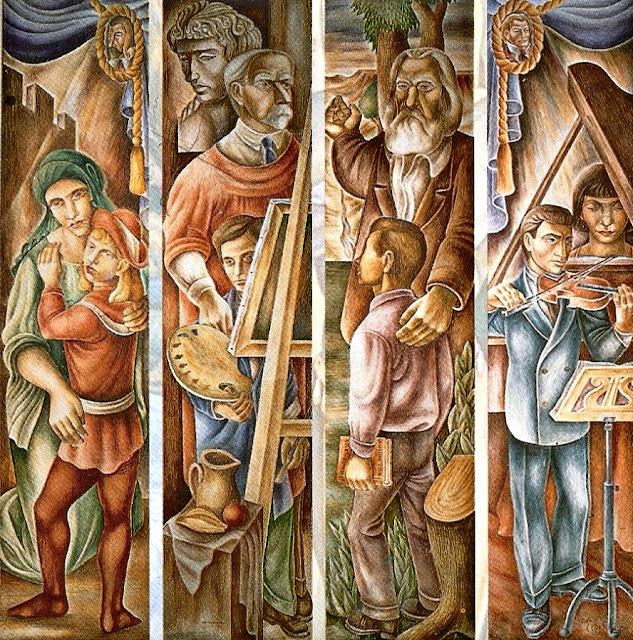Sculptor Cyrus Edwin Dallin (1861–1944) had great
reverence for Native Americans. Born in Utah, he grew up playing with Ute
Indian boys who lived in nearby encampments. In 1880, Dallin went to Boston to
train under Truman H. Bartlett, an accomplished sculptor. Several years later,
he moved to Paris to study at the Académie Julian. In Paris, Native Americans
became the focus of Dallin’s artwork. When Buffalo Bill’s Wild West Show came
to France to perform, Dallin had several Indians pose for him as models. In
1889, he began working on a sculpture depicting an Indian chief on horseback
holding a staff with a feather on it, symbolizing peaceful intentions. Dallin
named the artwork A Signal of Peace and displayed it at the Salon of 1890 in
Paris. A Signal of Peace, originally located just northwest of the Ulysses S.
Grant Monument, was moved to its current site east of Lake Shore Drive by the
mid-1920's to accommodate the expansion of the Lincoln Park Zoo. In the early
1940's, the Billy Caldwell Post of the American Legion petitioned to move the
bronze sculpture to the Caldwell Woods in the Cook County Forest Preserves. The
Chicago Park District denied the request.
1905-10 photo - Art Institute of Chicago

A memorial to the Ottawa Indians, The Alarm is one of the
oldest outdoor sculptures in Chicago. Donated by Chicago businessman Martin
Ryerson (1818–1887), the bronze sculptural group depicts a Native American
family. The male figure is standing alongside his dog and listening for danger
while the wife and baby are sheltered at his feet. The artwork is highly
detailed with realistic depictions of each element including the arrows'
feather fletching and ornate fabric that holds the baby to the cradleboard. Ryseron had great admiration for the Ottawa Indians. As a
young man he developed personal relationships with members of the tribe when he
traded furs with them. He went on to make his fortune in the lumber industry
and real estate. Ryerson commissioned the piece in 1880, long after the tribe
had been forced to resettle. Art historian Mary Lackritz Gray explains,
“Ryerson was especially anxious that the sculpture portray their strength of
character and peacefulness and avoid the stereotype of the unfeeling savage.”
This
was the first major commission for John J. Boyle (1851–1917), a
Philadelphia-born artist who had spent several months observing Native
Americans in North Dakota. The monument originally included bas-relief panels
on each side of its base entitled “The Peace Pipe,” “The Corn Dance,”
“Forestry,” and “The Hunt.” After the original bronze panels were stolen in the
late 1960s, the Park District replaced them with similar scenes of Ottawa life
carved into granite and installed on each face of the base. Though first
unveiled near the Lincoln Park Zoo, the monument was moved to its present
location on the lakefront in 1974 to make way for the new Ape House. - Chicago Park District
The Lake View's
Post Office Mural
There was countless programs in place during the 1930's to revive the economy and put folks back to work to feed their families - the WPA was one of them. The Works Progress Administration (WPA) was instituted by presidential executive order under the Emergency Relief Appropriation Act of April 1935, to generate public jobs for the unemployed. The WPA was restructured in 1939 when it was assigned to the Federal Works Agency. By 1936 over 3.4 million people were employed on various WPA programs. Administered by Harry Hopkins and furnished with an original congressional allocation of $4.8 billion, the WPA made work accessible to the unemployed on an unparalleled scale by disbursing funds for an extensive array of programs. The Federal Art Program was one of them. 1930's image - Kids Britannica
Under the direction of art critic and curator Holger Cahill, the Federal Art Project operated in all 48 states and instituted divisions for easel painting, murals, sculpture, posters, prints and drawings.The Federal Art Project division of the WPA tended to favor figurative art rather than abstract art; a trend that resulted in many of the century's greatest abstract painters (Rothko, Pollock, Krasner, etc.) creating rather uncharacteristic art. 
WPA’s Federal Art Project hired thousands of artists. “More than 20,000 paintings, murals and sculptures were produced by artists who were paid up to $42 a week. Among them were future superstars Jackson Pollock, Willem de Kooning, Mark Rothko and Thomas Hart Benton. Much of the art was installed in public places such as schools and hospitals.” Just in the past few years, the General Services Administration (GSA) has recovered at least 150 pieces of art. The Postal Service owns more than 1,200 murals and sculptures that were commissioned by the Treasury Department's Section of Fine Arts from 1934 to 1943. Post office art wasn't meant to create jobs, says Dallan Wordekemper, preservation officer for the Postal Service. Instead, artists competed to create works that would boost morale during the Depression. The idea, Wordekemper says, was to "bring art to the populace" without charge in a place they visited daily — the local post office. Art that is recovered and restored, he says, often goes right back on post office walls or libraries for the same reasons. - Parsley's Picks: buried treasure
This 1940 article below reflects a negative view of this part of the WPA program.


Work Projects Administration (WPA) in late 1930’s to create art for the Lake View Branch of the Chicago Post Office located
at Irving Park Road near Sheffield.
text - excerpt from 1982 Tempo article
image - from Chicago Tribunetext below - Guide to Chicago Murals 2001
photo - Jane Rosenbluth Baldwin
In 2010, the Chicago Branch of the Lake View Post Office was renamed after a legendary folk singer Steve Goodman.
photos below by Alex Bean
via Forgotten Chicago Discussion Group

Chicago's
Ephemeral Art
There are many forms of ephemeral art, from sculpture to
performance, but the term is usually used to describe a work of art that only
occurs once, like a happening, and cannot be embodied in any lasting object to
be shown in a museum or gallery.

Lake View's Own
Ephemeral Art
Once located on Elaine Place what was thought by the local residents to be permanent but was, in fact, just not
The three sculptures have been a staple of the
neighborhood for almost three decades and were the work of Chicago artist John
Kearney. Kearney is known for using steel objects, mostly car parts, to create
sculptures of animals. In Chicago, his work includes three deer in front of the
Aon Center, two horses owned by the Chicago Park District and a collection of
Wizard of Oz characters in Oz Park, including the Tin Man, Cowardly Lion,
Scarecrow, Dorothy and Toto. The owner of the Lakeview sculptures, Milton Zale,
also owned most of the buildings on the 3400 north block of Elaine Place, and
sold them to a group of investors – sans sculptures.
Residents were not happy with the abrupt removal. Bret
Beaudry said he was stunned when he found them gone and even thought, “Someone
might have tried to steal them.” George Eastman, who has lived on the street
for 30 years, remembers when the giraffes were put up. - WBEZ
photo - University of Illinois-Urbana/Champaign
After a long history, at least since 1978, on Elaine
Place there were these metal objects that were removed from the street in 2012.
The artist John Kearney, based in both in Chicago and Provincetown, was the
artist who created figurative sculptures, often of animals, using multiple,
found metal objects, specifically bumpers from cars.
1981 photo - William Brubaker Collection
via University of Illinois
Two Remain
at Roscoe/Elaine Place
as of July 2021
Milton Zale [seller of the property] said it simply was time to sell his property
in Lakeview, but the buyer of his buildings didn’t want to pay for the
insurance on the sculptures. You see, people like to climb them. Zale said the sculptures are being restored in a studio. Zale
said he would be willing to sell them, hoping they can go back to Elaine Place. - CBS Local
The removal October 11, 2012
Joe E. Dale contributor - Facebook
Separation Issues
2012 photo - Lake View Patch
a miniature made of aluminum
the (real) human form
photo by Boris Geissler - Chicago Phoenix/Facebook
in 2013
These sculptures are meant to be only temporary
A collaboration by Lincoln Park citizen associations and then later Lake View in 2008. This public art venture was first established in 2001 to be a statement of civic/corporate/community pride based on local neighborhood participation. This continuous & yearly exhibit was conceived to enrich the neighborhood landscape by publicly exhibiting the works of art by area sculptors along the streets & byways of our community.
'Public art is more important than ever. Chicago Sculpture
Exhibit is an ideal way for people to experience beautiful and inspiring art in
a safe way. With sculptures in so many Chicago communities, many people don't
even have to travel to enjoy a fun and educational activity.' - Chicago Sculpture Exhibit
Only Lake View
Locations ...
St. Luke's Parish on Belmont
Waveland & Wilton
Clark & Lincoln
Waveland & Wilton
Sheridan Road & Sheridan Road
Lincoln & School Street
Broadway & Roscoe Street
3505 Southport Avenue
Diversey & inner Lake Shore Drive
Grace & Southport - Blaine School
855 W Aldine
3757 N Clark Street
3108 Broadway
1500 W Belmont Avenue
100 East Diversey Parkway
just north of Diversey Harbor
east of the Signal of Peace Monument
*I suspect this one will be permanent*

3456 Elaine Place
3400 Elaine Place
921 W Barry Avenue
3423 N Southport Avenue
3840 N Southport Avenue
3400 Elaine Place
and a zoomed view below
3325 N Halsted Street
3400 N Elaine Pl
3456 N Elaine Place
3333 N Halsted Street
3310 N Broadway
this structure must have been installed prior to the pandemic
Nightingale 3801 Fremont Avenue
1047 W Irving Park Road
246 W Diversey Parkway
3423 N Southport Avenue
3310 N Broadway
3451 N Elaine Place
3401 N Elaine Place
3324 N Halsted Street
and
3401 N Elaine Place3451 N Elaine Place
Moonscape 1047 W Irving Park Road
and
3324 N Halsted
within Lake View
Art of all styles have become a fixture along
the renovated CTA stations in the city
Along the Redline
photos - CTA
Outdoor Sculpture
Along the Brownline
photos - CTA
Chicago Outdoor Sculpture
Bridge Underpass
 2018 photo - Scott Kleinberg
2018 photo - Scott Kleinberg
2012 photo - SunTimes
photo - Chicago Public Art Group

photos - Chicago Public Art Group
photos below - Garry Albrecht
2012 photo - James H.
Art Along the Tracks
Southport Style, Sentrock (2017-2018): 3410 N. Southport AveLow-Line Nosey No. 1, Rodney Duran (2023) Low-Line Nosey No. 2, Rodney Duran (2023)
Untitled, Antonio Beniquez (2020): 3409 N. Ashland Ave
Year Round, Mauricio Ramirez (2020-2021): 3415 N. Ashland Ave
and
The Bunny, Zor Zor Zor (2021-2022): 3410 N. Paulina St.The Lost Art
along the Shoreline
photos - A Place for Us LGBTQ Life at Belmont Rocks located new the Lincoln Park Gun Club
Like the caveman before them, artists carved their works of art on limestone blocks all over the world. Here on the shores near Belmont Harbor some beach-like bathers for their cue.
Some art was just plan old graffiti, some not. Thanks to a fellow Chicagoan photos of the countless works of art will not be forgotten. there was human art
and
there was limestone art
Depression Art
at Nettelhorst School
Another location of depression art and other murals by comtemporay local artists is located at Nettelhorst Elementary in Lake View
Contemporary Chicago
'Louis Nettelhorst School Elementary Alumni'-Facebook
Rudolph Weisenborn’s mural at Nettelhorst Elementary
shows his interest in modern European painting styles such as Cubism. Fractured
space, jagged lines, and vibrant primary colors convey Chicago’s energy and
modernity during the 1930s. On the left, an abstracted portrait of a
sophisticated urban dweller is followed by forms of modern transportation such
as small biplanes at Chicago Municipal Airport (Midway) and boats on Lake
Michigan. The right half of the composition shows the stockyards on Chicago’s
South Side and a construction worker holding an anvil and working on a steel
frame structure. A native of Chicago, Weisenborn worked for a time as a gold
miner and cowpuncher in Colorado before becoming an artist. He received four
years of academic art training before turning his attention to more avant-garde
painting styles. In addition to Contemporary Chicago, Weisenborn’s Chicago
mural commissions included the only abstract mural for The Century of Progress
(1933-34) exhibition and a mural series at Crane Technical High School.

2014 photo - Michael McLoughlin via
'Louis Nettelhorst School Elementary Alumni'- Facebook
and adding there own along the way
other art displays
in the original building, a 21st century photo
Louis Nettelhorst School Elementary Alumni-Facebook
entrance to the lunch room
Louis Nettelhorst School Elementary Alumni'-Facebook
One of the largest collection of WPA murals is located in
North Central. Here are some samples:
Four vertical panels mounted between the exterior doors of the Lane Tech auditorium describe
the teaching of the humanities


and more was added in 2016
be Called Art?
photos & text from DNAinfo
'The artist is Samantha Rausch. The art piece is titled "Endless." According to Rausch, it's meant to blend different concepts of time and life with the image of a dead tree.'
located between Stratford Place & Hawthorne Place/LSD
Art Supported
by Commerce
images - LakeView Roscoe Chamber of Commerce
The Lakeview Public Art Committee is responsible for
identifying innovative artists and securing funding to support the display of
public works of art in highly-visible locations throughout West Lakeview.
Consisting of volunteers who share diverse experience in the arts and
fundraising, the committee and its recommendations help advance the mission of
Friends of Lakeview, a 501(c)(3) non-profit organization and partner of the
Lakeview Roscoe Village Chamber of Commerce and Special Service Area (SSA) 27. 600 block of Roscoe
photo - Neil Allen
Post Notes:
Follow me to my next post called































































































































































































































No comments:
Post a Comment